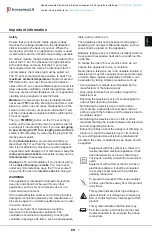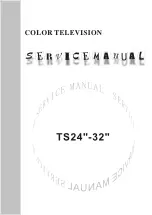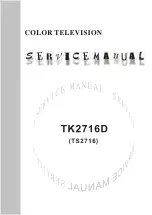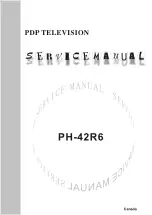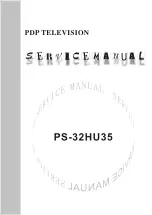
tube to the CRT ground of receiver before handling the tube.
8. After servicing make the following leakage current checks to prevent the
customer from being exposed to shock hazards.
1.2. LEAKAGE CURRENT COLD CHECK
1. Unplug the AC cord and connect a jumper between the two prongs on the plug.
2. For physically operated power switches, turn power on. Otherwise skip step 2.
3. Measure the resistance value, with an ohmmeter, between the jumpered AC plug
and each exposed metallic cabinet part on the receiver, such as screwheads,
connectors, etc. When the exposed metallic part has a return path to the chassis,
the reading should be between 1 M and 12 M . When the exposed metal does
not have a return path to the chassis, the reading must be infinity.
1.3. LEAKAGE CURRENT HOT CHECK
1. Plug the AC cord directly into the AC outlet.
Do not use a isolation transformer for this check.
2. Connect a 1.5 k , 10 W resistor, in parallel with a 0.15
F capacitor, between
each exposed metallic part on the set and a good earth ground, as shown in
Figure 1.
3. Use an AC voltmeter, with 1 k /V or more sensitivity, to measure the potential
across the resistor.
4. Check each exposed metallic part, and measure the voltage at each point.
5. Reverse the AC plug in the AC outlet and repeat each of the above measurements.
6. The potential at any point should not exceed 0.75 V RMS.
A leakage current tester (Simpson Model 229 equivalent) may be used to make
the hot checks. Leakage current must not exceed 1/2 mA. In case a measurement
is outside of the limits specified, there is a possibility of shock hazard, and the
receiver should be repaired and rechecked before it is returned to the customer.
Figure 1
4
Summary of Contents for PV-DF2700-K
Page 1: ...ORDER NO MKE0012601C1 B6 TV DVD VCR Combination PV DF2700 K SPECIFICATIONS 1 ...
Page 2: ...1 1 SAFETY PRECAUTIONS 1 1 GENERAL GUIDELINES 1 IMPORTANT SAFETY NOTICE 2 ...
Page 11: ...11 ...
Page 12: ...Fig 1 3 12 ...
Page 13: ...Fig 1 4 13 ...
Page 14: ...14 ...
Page 15: ...Fig 1 5 15 ...
Page 23: ...5 1 8 SERVICE POSITION 5 1 8 1 Service Position 23 ...
Page 28: ...28 ...
Page 30: ...6 Place it along with Guide ribs on the Bottom Frame as shown Fig 7 3 3 30 ...
Page 37: ...5 1 12 HOW TO INITIALIZE MEMORY IC 37 ...
Page 40: ...40 ...
Page 50: ...50 ...
Page 55: ...55 ...
Page 57: ...57 ...
Page 58: ...6 1 2 Disassembly Method 58 ...
Page 59: ...59 ...
Page 60: ...60 ...
Page 61: ...Fig D2 61 ...
Page 62: ...62 ...
Page 63: ...Fig D3 63 ...
Page 64: ...64 ...
Page 65: ...6 1 2 1 Notes in chart 1 Removal of VCR DVD Ass y Fig D4 2 Installation of VCR DVD Ass y 65 ...
Page 70: ...6 2 1 Disassembly Reassembly Method 70 ...
Page 71: ...71 ...
Page 72: ...6 2 2 Inner Parts Location Fig J1 1 6 2 3 EJECT Position Confirmation Fig J1 2 72 ...
Page 73: ...6 2 4 Grounding Plate Unit Full Erase Head and Cylinder Unit Fig J2 1 73 ...
Page 74: ...74 ...
Page 76: ...6 2 5 Capstan Belt Support Angle Intermediate Gear B and Main Cam Gear Fig J3 1 76 ...
Page 77: ...77 ...
Page 84: ...6 2 6 1 Reassembly Notes 1 Installation of Center Clutch Unit 84 ...
Page 87: ...6 2 8 Stopper Angle Capstan Rotor Unit Oil Seal Capstan Stator C B A and MR Head Fig J6 1 87 ...
Page 88: ...88 ...
Page 90: ...90 ...
Page 94: ...94 ...
Page 100: ...6 3 CASSETTE UP ASS Y SECTION 100 ...
Page 101: ...6 3 1 Top Plate Wiper Arm Unit and Holder Unit Fig K1 1 101 ...
Page 102: ...102 ...
Page 104: ...104 ...
Page 112: ...112 ...
Page 131: ...131 ...
Page 134: ...7 3 9 1 How to adjust 134 ...
Page 135: ...135 ...
Page 136: ...136 ...
Page 146: ...146 ...
Page 150: ...150 ...
Page 156: ...156 ...
Page 160: ...160 ...
Page 168: ...Fig E15 2 168 ...
Page 171: ...7 4 TEST POINTS AND CONTROL LOCATION 171 ...
Page 172: ...172 ...
Page 173: ...173 ...
Page 174: ...174 ...
Page 175: ...8 SCHEMATIC DIAGRAMS 175 ...




















